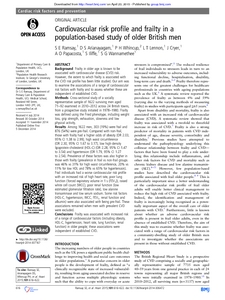Ramsay, SE; Arianayagam, DS; Whincup, PH; Lennon, LT; Cryer, J; Papacosta, AO; Iliffe, S; Wannamethee, SG
(2015)
Cardiovascular risk profile and frailty in a population-based study of older British men.
Heart, 101 (8).
pp. 616-622.
ISSN 1468-201X
https://doi.org/10.1136/heartjnl-2014-306472
SGUL Authors: Whincup, Peter Hynes
![[img]](https://openaccess.sgul.ac.uk/107375/1.hassmallThumbnailVersion/Cardiovascular_risk_profile_frailty_population_based_study_older_British_men.pdf)  Preview |
|
["document_typename_application/pdf; charset=binary" not defined]
Published Version
Download (822kB)
| Preview
|
Abstract
BACKGROUND: Frailty in older age is known to be associated with cardiovascular disease (CVD) risk. However, the extent to which frailty is associated with the CVD risk profile has been little studied. Our aim was to examine the associations of a range of cardiovascular risk factors with frailty and to assess whether these are independent of established CVD.
METHODS: Cross-sectional study of a socially representative sample of 1622 surviving men aged 71-92 examined in 2010-2012 across 24 British towns, from a prospective study initiated in 1978-1980. Frailty was defined using the Fried phenotype, including weight loss, grip strength, exhaustion, slowness and low physical activity.
RESULTS: Among 1622 men, 303 (19%) were frail and 876 (54%) were pre-frail. Compared with non-frail, those with frailty had a higher odds of obesity (OR 2.03, 95% CI 1.38 to 2.99), high waist circumference (OR 2.30, 95% CI 1.67 to 3.17), low high-density lipoprotein-cholesterol (HDL-C) (OR 2.28, 95% CI 1.47 to 3.54) and hypertension (OR 1.79, 95% CI 1.27 to 2.54). Prevalence of these factors was also higher in those with frailty (prevalence in frail vs non-frail groups was 46% vs 31% for high waist circumference, 20% vs 11% for low HDL and 78% vs 65% for hypertension). Frail individuals had a worse cardiovascular risk profile with an increased risk of high heart rate, poor lung function (forced expiratory volume in 1 s (FEV1)), raised white cell count (WCC), poor renal function (low estimated glomerular filtration rate), low alanine transaminase and low serum sodium. Some risk factors (HDL-C, hypertension, WCC, FEV1, renal function and albumin) were also associated with being pre-frail. These associations remained when men with prevalent CVD were excluded.
CONCLUSIONS: Frailty was associated with increased risk of a range of cardiovascular factors (including obesity, HDL-C, hypertension, heart rate, lung function, renal function) in older people; these associations were independent of established CVD.
Statistics
Item downloaded times since 23 Apr 2015.
Actions (login required)
 |
Edit Item |



